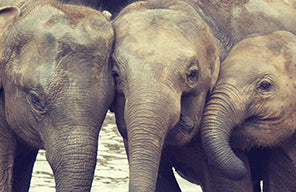Why Sri Lanka?
Sri Lanka is home to about a tenth of the world’s total 40,000 Asian elephants in the wild. However, elephants in Sri Lanka are being killed at an alarming rate—not for their tusks, meat, or hides—but simply because they interfere with agriculture. In Sri Lanka, an estimated 4,000 elephants have been destroyed since 1950.
The elephant is running out of space in Sri Lanka. The protected areas are inadequate, less than 1000 sq. km (900 sq. miles). Moreover, elephants, especially the bulls, may range over hundreds of square kilometers in the course of a season. Unfortunately in farming communities, their sheer size and gargantuan appetite make them a threat to crops.

Although there are no easy solutions for resolving the human-elephant conflict in Sri Lanka, much depends on how humans who live there perceive the worth of the elephant. Defenders of wildlife are now convinced that the only way for elephants and humans to co-exist successfully in the same environment is through developing ways in which the elephant is proven to be a sustainable economic resource.
Elephant dung may be the answer

It is a commodity that is freely available. On average, an adult elephant produces about 180-200 kg (500 lbs.) per day. Since an elephant’s diet is all vegetarian, the waste produced is basically raw cellulose. Thoroughly cleaned and processed, the cellulose is converted into a uniquely beautiful textured product. This acid-free, linen-like paper, marketed as Ellie Pooh paper, is made into art projects, notebooks, cards, and other exotic gifts.
New uses are being found every day; the only limit is one’s imagination. Products made from Ellie Pooh paper are popular among the local population in Sri Lanka, as well as in several countries, including America.


